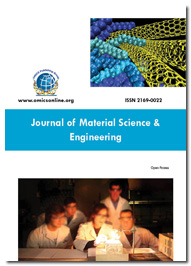Theme: Functional Energy Materials for Sustainable Future
Energy Materials 2017
After the great success of the Materials Science 2016, ConferenceSeries LLC Ltd officially announces “the 14th International Conference on Energy and Materials Research” to be held during December 6-7, 2017 in Dallas, Texas, USA along with Editorial Board Members, External Scientific Association, Researchers, Academicians, and Market leaders around the globe. Energy Materials 2017 is comprised of leading tracks designed to offer comprehensive and interesting sessions that define the current research strategies in the field of Materials science with the theme: Functional Energy Materials for Sustainable Future.
ConferenceSeries LLC Ltd organizes 3000+ Global Events with over 600+ Conferences, 1200+ Symposiums and 1200+ Workshops in USA, Europe & Asia with support from 1000 more scientific societies and publishes 700+ Open access journals which contains over 30000 eminent personalities, reputed scientists as editorial board members.
Why Dallas, USA?
Dallas is one of the main cities of Texas and fourth most populous metropolitan city in United States. The city's noticeable quality emerged from its recorded significance as a center of the oil and cotton industries and various railroad lines. The greater part of the city is in Dallas County, of which it is situated; in any case, areas of the city are situated in Collin, Denton, Kaufman, and Rockwall districts. As per the 2010 United States Census, the city had a populace of 1,197,816. The United States Census Bureau's gauge for the city's populace expanded to 1,300,092 as of July 1, 2015.
A humid subtropical climate is there in Dallas which generally experiences in the Southern Plains of the United States. In winter, the average minimum and maximum temperature are experienced 3 °C and 14°C respectively with common snowfall. Summer is hot and humid with minimum and maximum temperature of 25 °C and 36 °C respectively. The price of oil has dropped suddenly in mid-2014 and increasing throughout 2015 has not affected the city and its huge metro due to its highly diversified economic nature. The growth of Dallas has not been affected by this whereas the other oil dependent regions had to suffer significantly in 2015. Dallas was considered as a "beta in addition to" world city by the Globalization and World Cities Study Group and Network and also ranked fourteenth in world GDP rankings by the Organization for Economic Co-operation and Development as per the recent discharged ranking in 2013.
Theme: Functional Energy Materials for Sustainable Future
Energy Materials 2017
Summary:
Energy Materials are crucial to monetary, social and mechanical improvement. They shape the reason for the usefulness of the fabricated environment, items and advances that are essential to cutting edge society. This implies they can be the key creative trigger in the improvement of numerous new items and advances. Because of the high demand of energy, the researchers have focused on the energy materials for better future. This report distinguishes a hefty portion of the key issues identified with research on, and advancement of, new materials in support of rising low carbon vitality advances for market organization by 2050. A finish of key issues and topics, gathered from the presentations and talks by world’s leading professionals and academicians of this field, is contained in this report.
Recognizing the importance of this aspect, ConferenceSeries LLC Ltd is pleased to invite all of you to the 14th International Conference on Energy and Materials REsearch during December 06-07, 2017 in Dallas, Texas, USA with the theme: Functional Energy Materials for Sustainable Future that will cover the wide range of topics from Energy Materials and Materials Science. For more details please visit: http://energymaterials.conferenceseries.com/
Importance & Scope:
There are 1.4 billion people living without access to electricity and an additional 2 billion living with unsafe and inadequate sources of electricity. People don’t always require energy just when the grid is on, when the sun is out, when the wind is blowing, or, in the oldest of storage applications, when water is available. Without storage, most energy solutions would be wasted. Energy must be stored whenever accessible or available.
Energy storage is crucial for the most basic activities, for example, lighting a home at night or maintaining access to a mobile phone for longer than one day. In most emerging markets, however, it’s not as simple as plugging a phone into the wall: the grid’s power supply may be down or the user is paying for every minute of charging at a local merchant’s shop. Even for those users with off-grid, decentralized solutions, storage is essential. Most renewable energy systems, solar home systems for example, come with a battery because you don’t need lights when the sun is out.
Energy storage systems are in operation or under development in nearly every U.S. state. These projects range from small (like the project that recycles electricity from Philadelphia’s mass transit system) to the very large (such as major reservoirs and pumping facilities in South Carolina and Missouri). Energy storage is at work in a host of new and exciting applications across four main categories: electrical, mechanical, thermal, and chemical. Examples in the electric category include superconducting magnetic energy storage and capacitors. Pumped hydroelectric power, compressed air, and flywheels represent mechanical storage mechanisms. Batteries are the most common type of chemical storage, and ice is the most common form of thermal storage. Energy storage supports the integration of renewable energy generation.
Energy storage can also help cut emissions as it takes more of the load off fossil-fuel generation. Peaking generation is one of the most costly and wasteful aspects of the grid, so making existing generation go further and avoiding capital and resource-intensive new facilities would make a significant contribution to our environmental priorities. By supporting an all-of-the-above energy strategy, storage will also help accelerate our drive to energy independence.
Why Dallas …?
Dallas is one of the main cities of Texas and fourth most populous metropolitan city in United States. The city's noticeable quality emerged from its recorded significance as a center of the oil and cotton industries and various railroad lines. The greater part of the city is in Dallas County, of which it is situated; in any case, areas of the city are situated in Collin, Denton, Kaufman, and Rockwall districts. As per the 2010 United States Census, the city had a populace of 1,197,816. The United States Census Bureau's gauge for the city's populace expanded to 1,300,092 as of July 1, 2015.
A humid subtropical climate is there in Dallas which generally experiences in the Southern Plains of the United States. In winter, the average minimum and maximum temperature are experienced 3 °C and 14°C respectively with common snowfall. Summer is hot and humid with minimum and maximum temperature of 25 °C and 36 °C respectively. The price of oil has dropped suddenly in mid-2014 and increasing throughout 2015 has not affected the city and its huge metro due to its highly diversified economic nature. The growth of Dallas has not been affected by this whereas the other oil dependent regions had to suffer significantly in 2015. Dallas was considered as a "beta in addition to" world city by the Globalization and World Cities Study Group and Network and also ranked fourteenth in world GDP rankings by the Organization for Economic Co-operation and Development as per the recent discharged ranking in 2013. Dallas is the home of many materials company like energy materials, polymers and nanotechnology.
Why to attend???
Materials Science 2016 was a great success and we believe that this credit goes to the Organizing Committee and participants of Materials Science 2016 Conference. Based on their support and cooperation, ConferenceSeries LLC Ltd feels honor to announce the 14th International Conference on Energy and Materials Research during December 06-07, 2017 in Dallas, Texas, USA with the theme: Functional Energy Materials for Sustainable Future.
If you are looking for such events, where you can explore the discoveries and theories in the field of Energy Materials and Materials Science, here is your opportunity… Energy Materials 2017 is going to be the best platform for the materials researchers and students where you can discuss research work and learn new strategies about the current scenario of materials market. Conduct workshops, meet with highly experienced scientists, distribute knowledge, and receive name recognition by making networking at this 2-day conference. And Dallas is one of the most popular tourist attraction where you can give a great time with your family a wonderful tourism experience. You will also get an opportunity to exhibit respective company.
This conference is organized on all the major topics in the fields of Advances in Energy Materials and Materials Science. It also would be beneficial for all the PhD candidates and students who are willing to enter into corporate as well as the research targeting to the respective field.
You will get a chance to form network and contact with established Research institutes/ Industries in the respective field.
So hurry up and book your slot today for Energy Materials 2017!!
For more information please click here
Theme: Generation of Energy Evolution for Sustainable Future
Energy Materials and Fuel Cell Research 2018
Summary:
Energy Materials and Hydrogen & Fuel Cell are crucial to monetary, social and mechanical improvement. They shape the reason for the usefulness of the fabricated environment, items and advances that are essential to cutting edge society. This implies they can be the key creative trigger in the improvement of numerous new items and advances. Because of the high demand of energy, the researchers have focused on the energy materials and fuel cells for better future. This report distinguishes a hefty portion of the key issues identified with research on, and advancement of, new materials in support of rising low carbon vitality advances for market organization by 2050. A finish of key issues and topics, gathered from the presentations and talks by world’s leading professionals and academicians of this field, is contained in this report.
Recognizing the importance of this aspect, Conference Series LLC Ltd is pleased to invite all of you to the 2nd International Conference on Energy Materials and Fuel Cell Research during August 27-28, 2018 in Boston, Massachusetts, USA with the theme: Generation of Energy Evolution for Sustainable Future that will cover the wide range of topics from Energy Materials, Hydrogen & Fuel Cell Technology and Materials Science. For more details please visit: https://energymaterials.conferenceseries.com/
Importance & Scope:
There are 1.4 billion people living without access to electricity and an additional 2 billion living with unsafe and inadequate sources of electricity. People don’t always require energy just when the grid is on, when the sun is out, when the wind is blowing, or, in the oldest of storage applications, when water is available. Without storage, most energy solutions would be wasted. Energy must be stored whenever accessible or available.
For Energy Materials & Fuel Cells and Hydrogen, 2017 was a notable year on many fronts. Fuel cells and hydrogen continued to expand in existing markets and made inroads into new areas. Ongoing research, development, and demonstration (RD&D) projects examined additional uses for fuel cells and hydrogen, such as ground support equipment, drayage trucks, and energy storage.
A major development was the introduction of the third commercial fuel cell electric vehicle (FCEV), the Honda Clarity Fuel Cell, with sales starting in March in Japan and in December in California, the U.K., and Denmark. The Clarity Fuel Cell joins two other commercial FCEVs, the Toyota Mirai and Hyundai Tucson Fuel Cell, which have cumulatively sold or leased more than 1,000 units in the U.S. and nearly 3,000 worldwide through late 2017.
Hydrogen infrastructure continued to grow in 2016-17, with 92 new hydrogen refueling stations opened worldwide in 2016-17, and 83 being retail hydrogen stations that are accessible by customers. Almost half of these new hydrogen stations were opened in Japan (45), followed by California (20), with these two comprising 70 percent of the new hydrogen stations opened in 2016-17. Sales and deployments continued to grow in the material handling market, with more than 14,000 fuel cell forklifts in operation globally at the end of 2017, compared to more than 10,000 at the end of 2016.
Fuel cells also began to expand into new applications during the year, including passenger trains; drayage trucks, long-haul trucks, and delivery vans; and carbon capture from natural gas-fired power generation and oil sands sites. Fuel cells electrochemically combine hydrogen and oxygen to produce electricity, water, and heat. Unlike batteries, fuel cells continuously generate electricity as long as a source of fuel is supplied. Fuel cells do not burn fuel, making the process quiet, pollution-free, and up to two to three times more efficient than combustion technologies. A fuel cell system can be a truly zero-emission source of electricity when using hydrogen produced from nonpolluting sources.
Energy materials & storage systems are in operation or under development in nearly every U.S. state. These projects range from small (like the project that recycles electricity from Philadelphia’s mass transit system) to the very large (such as major reservoirs and pumping facilities in South Carolina and Missouri). Energy storage is at work in a host of new and exciting applications across four main categories: electrical, mechanical, thermal, and chemical. Examples in the electric category include superconducting magnetic energy storage and capacitors. Pumped hydroelectric power, compressed air, and flywheels represent mechanical storage mechanisms. Batteries are the most common type of chemical storage, and ice is the most common form of thermal storage. Energy storage supports the integration of renewable energy generation.
Energy storage can also help cut emissions as it takes more of the load off fossil-fuel generation. Peaking generation is one of the most costly and wasteful aspects of the grid, so making existing generation go further and avoiding capital and resource-intensive new facilities would make a significant contribution to our environmental priorities. By supporting an all-of-the-above energy strategy, storage will also help accelerate our drive to energy independence.
Why Dallas …?
Boston is one of the oldest cities and is the capital and most populous city of the Commonwealth of Massachusetts in the United States. It has become the latest city to commit to running on 100% renewable energy. It’s plenty of museums, historical sights and abundance of live exhibitions for this reason the city gets 16.3 million visitors a year, making it one of the ten most prominent visitor areas in the nation. Boston is surrounded by the "Greater Boston" region. Boston is sometimes called a "city of neighborhoods" as a result of the bounty of differing subsections; the city government's Office of Neighborhood Services has authoritatively assigned 23 neighborhoods. Boston has a humid continental climate. Boston's schools and colleges apply a huge effect on the territorial economy. Boston pulls in more than 350,000 understudies from around the globe, who contribute more than US$4.8 billion every year to the city's economy. Boston has been known as the "Athens of America" for its abstract culture, procuring notoriety for being "the scholarly capital of the United States."
Why to attend???
Energy and Materials Research 2017 was a great success and we believe that this credit goes to the Organizing Committee and participants of Energy & Materials Research 2017 Conference. Based on their support and cooperation, Conference Series LLC Ltd feels honor to announce the 2nd International Conference on Energy Materials and Fuel Cell Research during August 27-28, 2018 in Boston, Massachusetts, USA with the theme: Generation of Energy Evolution for Sustainable Future.
If you are looking for such events, where you can explore the discoveries and theories in the field of Energy Materials and Hydrogen & Fuel Cell Technology, here is your opportunity… Energy Materials 2018 is going to be the best platform for the materials researchers and students where you can discuss research work and learn new strategies about the current scenario of materials market. Conduct workshops, meet with highly experienced scientists, distribute knowledge, and receive name recognition by making networking at this 2-day conference. And Boston is one of the most popular tourist attractions where you can give a great time with your family a wonderful tourism experience. You will also get an opportunity to exhibit respective company.
This conference is organized on all the major topics in the fields of Advances in Energy Materials and Fuel Cells Research. It also would be beneficial for all the PhD candidates and students who are willing to enter into corporate as well as the research targeting to the respective field.
You will get a chance to form network and contact with established Research institutes/ Industries in the respective field.
So hurry up and book your slot today for Energy Materials 2017!!
For more information please
Conference Highlights
- Advanced Energy Materials
- Solar Energy Materials
- Nanotechnology in Materials Research
- Advanced Nanomaterials
- Batteries and Energy Materials
- Advanced Graphene Materials
- Hydrogen Energy
- Polymer Energy Materials
- Entrepreneurs Investment Meet
- Materials Science & Engineering
- Biomaterials and Surface Science Engineering
- Mining, Metallurgy and Materials Science
- Electrical, Optical and Magnetic Materials
To share your views and research, please click here to register for the Conference.
To Collaborate Scientific Professionals around the World
| Conference Date | December 06-07, 2017 | ||
| Sponsors & Exhibitors |
|
||
| Speaker Opportunity Closed | Day 1 | Day 2 | |
| Poster Opportunity Closed | Click Here to View | ||
Useful Links
Special Issues
All accepted abstracts will be published in respective Our International Journals.
- Journal of Material Sciences & Engineering
- Innovative Energy & Research
- Journal of Fundamentals of Renewable Energy and Applications
Abstracts will be provided with Digital Object Identifier by





















